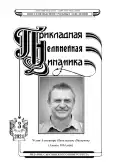Using machine learning algorithms to determine the emotional maladjustment of a person by his rhythmogram
- Authors: Stasenko S.V.1, Shemagina O.V.2, Eremin E.V.1, Yakhno V.G.2, Parin S.B.1, Polevaia S.A.1
-
Affiliations:
- Lobachevsky State University of Nizhny Novgorod
- Institute of Applied Physics of the Russian Academy of Sciences
- Issue: Vol 32, No 3 (2024)
- Pages: 394-404
- Section: Nonlinear dynamics and neuroscience
- URL: https://journals.rcsi.science/0869-6632/article/view/256165
- DOI: https://doi.org/10.18500/0869-6632-003098
- EDN: https://elibrary.ru/RHZIPK
- ID: 256165
Cite item
Full Text
Abstract
About the authors
Sergey Victorovich Stasenko
Lobachevsky State University of Nizhny Novgorod
ORCID iD: 0000-0002-3032-5469
Scopus Author ID: 55327776400
ResearcherId: J-4825-2013
603950 Nizhny Novgorod, Gagarin Avenue, 23
Olga Vladimirovna Shemagina
Institute of Applied Physics of the Russian Academy of Sciencesul. Ul'yanova, 46, Nizhny Novgorod , 603950, Russia
Evgeny Viktorovich Eremin
Lobachevsky State University of Nizhny Novgorod
ORCID iD: 0000-0001-5707-6063
Scopus Author ID: 57196752333
603950 Nizhny Novgorod, Gagarin Avenue, 23
Vladimir Grigorevich Yakhno
Institute of Applied Physics of the Russian Academy of Sciences
ORCID iD: 0000-0002-4689-472X
Scopus Author ID: 35554909600
ResearcherId: L-1813-2017
ul. Ul'yanova, 46, Nizhny Novgorod , 603950, Russia
Sergej Borisovich Parin
Lobachevsky State University of Nizhny Novgorod
ORCID iD: 0000-0001-5721-8762
Scopus Author ID: 6602724059
603950 Nizhny Novgorod, Gagarin Avenue, 23
Sofia Alexandrovna Polevaia
Lobachevsky State University of Nizhny Novgorod
ORCID iD: 0000-0002-3896-787X
Scopus Author ID: 6504648647
ResearcherId: C-7512-2012
603950 Nizhny Novgorod, Gagarin Avenue, 23
References
- Miskowiak KW, Johnsen S, Sattler SM, Nielsen S, Kunalan K, Rungby J, Lapperre T, Porsberg CM. Cognitive impairments four months after COVID-19 hospital discharge: Pattern, severity and association with illness variables. European Neuropsychopharmacology. 2021;46:39–48. doi: 10.1016/j.euroneuro.2021.03.019.
- Baig AM. Chronic COVID syndrome: Need for an appropriate medical terminology for long COVID and COVID long-haulers. J. Med. Virol. 2021;93(5):2555–2556. doi: 10.1002/jmv.26624.
- Yelin D, Wirtheim E, Vetter P, Kalil AC, Bruchfeld J, Runold M, Guaraldi G, Mussini C, Gudiol C, Pujol M, Bandera A, Scudeller L, Paul M, Kaiser L, Leibovici L. Long-term consequences of COVID-19: research needs. The Lancet Infectious Diseases. 2020;20(10):1115– 1117. doi: 10.1016/S1473-3099(20)30701-5.
- Chen C, Haupert SR, Zimmermann L, Shi X, Fritsche LG, Mukherjee B. Global prevalence of postcoronavirus disease 2019 (COVID-19) condition or long COVID: A meta-analysis and systematic review. The Journal of Infectious Diseases. 2022;226(9):1593–1607. doi: 10.1093/infdis/jiac136.
- Alkodaymi MS, Omrani OA, Fawzy NA, Shaar BA, Almamlouk R, Riaz M, Obeidat M, Obeidat Y, Gerberi D, Taha RM, Kashour Z, Kashour T, Berbari EF, Alkattan K, Tleyjeh IM. Prevalence of post-acute COVID-19 syndrome symptoms at different follow-up periods: a systematic review and meta-analysis. Clinical Microbiology and Infection. 2022;28(5):657–666. doi: 10.1016/j.cmi.2022.01.014.
- Stasenko SV, Kazantsev VB. Covid olfactory dysfunction model. In: 2023 Fifth International Conference Neurotechnologies and Neurointerfaces (CNN). IEEE; 2023. P. 82–85.
- Stasenko SV. Mean-field model of tripartite synapse with infected glial cells. In: 2023 Fifth International Conference Neurotechnologies and Neurointerfaces (CNN). IEEE; 2023. P. 78–81.
- Song M. Psychological stress responses to COVID-19 and adaptive strategies in China. World Development. 2020;136:105107. doi: 10.1016/j.worlddev.2020.105107.
- Stasenko SV, Hramov AE, Kazantsev VB. Loss of neuron network coherence induced by virusinfected astrocytes: a model study. Scientific Reports. 2023;13(1):6401. doi: 10.1038/s41598- 023-33622-0.
- Stasenko SV, Kovalchuk AV, Eremin EV, Drugova OV, Zarechnova NV, Tsirkova MM, Permyakov SA, Parin SB, Polevaya SA. Using machine learning algorithms to determine the post-COVID state of a person by their rhythmogram. Sensors. 2023;23(11):5272. doi: 10.3390/s23115272.
- Aleksandrovsky YA. Borderline Mental Races Construction. Moscow: Medicina; 2000. 496 p. (in Russian).
- Parfenov VA, Yakhno NN. General Neurology. Moscow: MIA; 2000. 209 p. (in Russian).
- Wise TN, Mann LS, Shay L. Alexithymia and the five-factor model of personality. Comprehensive Psychiatry. 1992;33(3):147–151. doi: 10.1016/0010-440x(92)90023-j.
- Runova EV, Grigoreva VN, Bakhchina АV, Parin SB, Shishalov IS, Kozhevnikov VV, Nekrasova MM, Karatushina DI, Grigoreva KА, Polevaya SА. Vegetative correlates оf conscious representation оf emotional stress. Modern Technologies in Medicine. 2013;5(4):69–76.
- Grigorieva VN, Tkhostov AS. A method for assessing emotional new human condition. Patent No. 2291720.2007 Russian Federation, IPC A61M21/00: appl. 08.09.2005: publ. 20.01.2007. Assignee: Nizhny Novgorod State Medical Academy of the Federal Agency for Health and Social Development. 23 p. (in Russian).
- Hosmer DW, Lemeshow S. Applied Logistic Regression. 2nd ed. New York, Chichester: Wiley; 2002. 392 p. doi: 10.1002/0471722146.
- Liu X-Y, Wu J, Zhou Z-H. Exploratory undersampling for class-imbalance learning. IEEE Transactions on Systems, Man, and Cybernetics, Part B (Cybernetics). 2009;39(2):539–550. doi: 10.1109/TSMCB.2008.2007853.
- Hastie T, Tibshirani R, Friedman J. Boosting and additive trees. In: The Elements of Statistical Learning. Springer Series in Statistics. New York: Springer; 2009. P. 337–387. doi: 10.1007/978- 0-387-84858-7_10.
- Schapire RE. Explaining AdaBoost. In: Scholkopf B, Luo Z, Vovk V, editors. Empirical Inference. Berlin, Heidelberg: Springer; 2013. P. 37–52. doi: 10.1007/978-3-642-41136-6_5.
- Kramer O. Scikit-learn. In: Machine Learning for Evolution Strategies. Vol. 20 of Studies in Big Data. Cham: Springer; 2016. P. 45–53. doi: 10.1007/978-3-319-33383-0_5.
- Lemaitre G, Nogueira F, Aridas CK. Imbalanced-learn: A python toolbox to tackle the curse of imbalanced datasets in machine learning. The Journal of Machine Learning Research. 2017; 18(1):1–5.
Supplementary files










